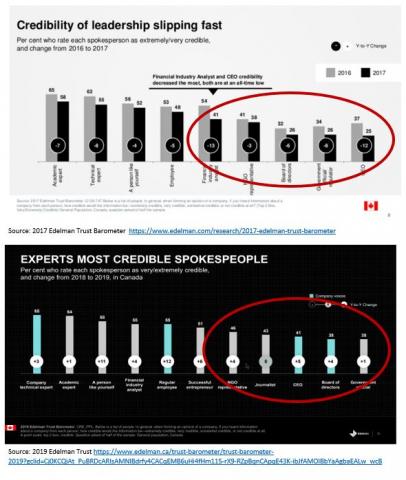The Gift and Significance of Trustworthiness in Leaders

An Opportunity for Leadership Education
One of the most daunting trends currently is declining credibility in leadership generally. The Edelman Trust Barometer keeps track of levels of trust in countries across the world by conducting an annual trust survey. As depicted below with the most vulnerable sectors highlighted, the survey in Canada reflects the concerning fact that Canadians who trust business leaders, government officials, and even NGO representatives is a small and declining minority 2016 and 2017 with only a slight upswing in 2019.

Francis Fukuyama (1995) considered deterioration and disconnection among people in a society to be a “direct tax imposed by the breakdown of trust in the society” (p. 11). Stephen Covey (2006) applied this notion to life in organizations and also turned it around calling trust a “dividend”: “When trust is high, the dividend you receive is a performance multiplier, elevating and improving every dimension of your organization and your life” (p. 19). The cost of mistrust and distrust is clear.
Leadership education has been focused on developing leaders’ to work with people rather than over them, team-building capabilities, communication, support to learning, and fostering positive relationships that amplifying environments of safety and respect. These are dimensions of leadership that contribute to leaders’ trustworthiness (Hurley, 2012). So, we imagine, on a good day, that our approach to leadership education has advanced people well in their workplaces and improved organizational life more generally.
Increasingly, though, trust in leaders becomes more complex. Accelerating change and unpredictability in our world requires organizations to be adaptive and to innovate continuously. Leading through change into ‘the unfamiliar’ requires a more solid sense of trust in leaders. Yet, at the same time, by implication leaders, who have been expected to be knowledgeable experts, do not know with any certainty what changing conditions will bring. It is in this context leaders’ integrity becomes a powerful basis for trust by others.
Integrity is generally recognized as ‘walking’ our ‘talk’. This is deceptively simple. In practice, integrity is necessarily accompanied by courage (aligning actions with words in the face of adversity) and authenticity (being who we really are). However, since brutal leaders can deliver on their destructive promises, as we have witnessed in the public sphere recently, creating trusting environments requires integrity to be accompanied by honesty, fairness, and caring/compassion (Palanski & Yammarino, 2007). A second challenge in acting with integrity is the accelerating pace of the world and workplace which requires us to act in the moment. This implies that our talk must become firmly embedded in our preconscious minds to inform rapid decision-making and intuitive action.
Strengthening our practice of integrity is one of the defining features of values based leadership education as exemplified by our Graduate Certificate in Values-Based Leadership, which launched in 2011. Our courses are ‘laboratories’ where we work together to hear hard truths about ourselves so that we can embody our values in who we are as people and leaders even in our most demanding times.
In addition, we are currently forwarding a new MA Leadership specialization for Executive Leadership. This education will enable mid- to senior-level leaders to develop their capabilities and characters focussing on values alignment, lasting culture change, and organizational innovation. Our Graduate Certificate in Values-Based Leadership program will serve as the first three foundational courses in this new Master's specialization.
References:
Covey, Stephen (2006) The speed of trust: The one thing that changes everything. New York: Simon & Schuster.
Fukuyama, Francis (1995) Human nature and the reconstitution of social order. New York: Free Press Paperbacks.
Hurley, R. (2012). The trustworthy leader: The first step toward creating high trust organizations. Leader to Leader (66), 33.
Palanski, M. E. and F. J. Yammarino (2007). Integrity and leadership. European Management Journal, 25(3), 171-184.
___
To find out more about our programs and dates for upcoming information session, visit the School of Leadership Studies website.
Make sure to stay connected with us on social media!